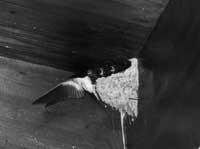Our swallows
Any town or neighborhood of Euskal Herria, the first solar meadows of early April and the first swallows revolving around the countryside. Every year we have the opportunity to enjoy the same show when, after spending the winter in the area of Africa, thousands of swallows return in good weather to our fields, hamlets, valleys and mountains. Usually in late March or early April.
Then, when the snow and ice are over and the temperature rises, the swallows leave their greenhouses in the middle and south of Africa and undertake a long journey north. Some will reach Norway and Russia, and another eleven will remain in the Basque Country, adorning with their fast planes the same atrium of villages and hamlets that many were born.

Its incredible migrations, its arrival in the spring and its condition of favorite species have made this bird a well-known and beloved bird. Swallows have always been known in Euskal Herria and linked to the human being, it is also seen in the language itself. To designate these cheerful and noisy birds, the Basque language has gathered more than fifteen words. Some such as the ainara, the anteiglesia or the yerna, known by the majority; others not so much as the Biscayan boletxa, the quinuria of the Baja Navarra or the bishop of Navarra. All these names, and many others, are part of the same Latin scientific name. They form the family Hirundinidae, unknown to many for the abundance of species of swallows and the existence of four in the Basque Country itself, similar in some things, but, as we will see, each has its characteristics and curiosities.
The birds that make up the group Hirundinidae (which we will call swallows to facilitate), except for New Zealand and the two poles, have spread all over the world knowing more than one hundred species. They are usually small birds, 13 to 20 cm, with wide mouth, short beak and long tail and grid. In general, they have strong, narrow and sharp wings, so they are magnificent flying, fast and light. Flying back and forth, they catch mosquitoes, flies, butterflies, etc. in the air. Who hasn't seen looking for insects in the sunset zone sucking fields and wells! Outside this world so dominated, however, they are quite clumsy for their weak and small legs, so they rarely descend to the ground.
As we have said, they are known practically all over the world. This is the case of the reddish North American dwarf, Progne subis, so varied on other continents, or the African abyssinic Hirundo, both linked to human construction and very numerous. For several years, as migration to September is about to begin, groups of 100,000 reddish swallows have been seen in Canada. In Asia also live numerous species and finally in Europe another five.
Four of them approach the surroundings of our villages, mountains and streams: common enara ( Hirundo rustica), enara azpizuria ( Delichon urbica), rock rock ( Hirundo rupestris) and plane zapador ( Riparia riparia). But be careful! However, do not confuse it with other birds that can be seen forming large groups in our villages and especially in our cities. Of course I mean the sorbells. The sorbells ( Apus apus) visit us between May and July. Many people think they are swallows, but they don't. They are members of another order, of the order of the apodiformes and although they have something similar, they have many anatomical, physiological and ethological differences. Therefore, do not confuse them with the rest. And we will leave the sorbells to talk about our four swallows.
Common swallow
Undoubtedly, the best known is the common swallow ( Hirundo rustica). The largest of the people living in Euskal Herria, its rabid tail surprises us when we see it. The two outer feathers of the tail, the two outer records, are enormously long and thin, being this characteristic enough to differentiate itself already from its triduous brothers. Black back and head, red chest and white belly. It has always been attached to humans and rarely can their nests be found in rocks, bridges or trees. He prefers human constructions, but that is far from the big cities and towns; he prefers the tranquility of the hamlets or the small neighborhoods.
It is not as colonial as the rest of the swallows, but it is always dedicated to hunting in small groups to avoid the competition that could have with the fields of bristles and swallows, distributing the preserve. The sorhermoso capture insects located in the upper zone, the sirloins in the center and the swallows in the terrestrial environment. He loves hunting in meadows and ponds near the nest, capturing small mosquitoes, efimeras and other insects with his skilful and fast flight. That flying ability also makes us clear when it comes to drinking water, as it does not have to stop: when you are flying above the wells a few millimeters, lower your head, put the beak in the water and, without any problem, take a tragoxka while leaving us fondly.
The truth is that most of the day is given in the air or in the wires and just goes down to the ground in the breeding season to collect the clay to nest. At this time it approaches streams, wells and springs. At the peak they take pieces of mud and mud, together with the herbs and balls that form after mixing with the saliva, they build in the lobbies and seals nests in the form of cup so known and open from above.
In recent years its population has suffered a sharp decline due mainly to pollution and the influence of pesticides. However, it is still found throughout the Basque Country. Of course, it is more abundant in the provinces of the South, since in Alava and Navarre it finds places more suitable for nesting, but in the other five territories it is also easy to find it if we move away from the large and contaminated villages.
Enara steak
While in recent years the expansion of towns and cities has limited the common swallow to the surroundings of the hamlet, the enara azpizuria (Delicho urbica) has adapted much better to modern life. It has not abandoned the mountains and, together with the common swallow, it can live in hamlets and neighborhoods, but no matter the nest anywhere, it has managed to colonize towns and cities and has not suffered the recoil suffered by the common swallow. Today it is not difficult to fly in large towns like Arrasate, Irun or Durango.

Although it may seem a little bit, it is easy to separate the sublengua from the rest. To begin with, despite having the grille tail, it does not have those two long feathers with normal swallows. And on the other hand, although the back and tail are black, the white-white spot on the ass is very evident. It is very evident especially in flight. Swallow is less than common and less slender. It is a very sociable species and can form colonies of hundreds of couples, although most of the time they live in groups of 10-20 couples. The whole team goes hunting at once and all at once return to the nest.
As mentioned above, the mountains and hamlets that most liked to live in ancient times have not been abandoned, but little by little it has spread throughout Euskal Herria and today we can find them throughout the territory: From the mountain ranges like Aralar, Elgea, Aizkorri or Salbada to the cities and from the coast to the plains of southern Alava and Navarre. This is probably the most abundant today.
Peña
The other species that is being distributed throughout our territory is the rock ( Hirundo rupestris). More unknown and less known than the previous two, the rock is one of the most alive, fast and acrobatic in the world. In flight it resembles the common swallow, but it is faster and daring. It also catches flies, wasps, ants, etc. in flight, but is also able to catch insects on the ground on rock due to its ability to fly. They are often observed, in a detached way, that they abandon the laws of physics and make surprising loops and jumps or fly giving an insect.
It is the heaviest of those living in Europe. Brown back and head, slightly darker wings and light belly, but not as white as the other swallows. These characteristics are usually sufficient when identifying this bird, but the clearest test to solve all doubts we find when we take a small look at its tail: it is square, not the grid, and also when it extends the tail to turn, they are very visible in it, both above and below.
In addition to these, the rocky river has other characteristics that distinguish it ethologically from other species. To begin with it is more mountainous than the rest, that is, it prefers the mountains and rocks to the neighborhoods, hamlets and meadows. Also, place the nest between the rocks and not in human houses or constructions. And finally, it descends more frequently to the ground than other species, as it likes to temper the sun lying on the stone.
It may not be as abundant as the previous two, but it can be found in any rock of Euskal Herria in small groups, especially in the mountains. In addition, in recent years its population has been growing and colonizing new environments. For example, I myself have detected it in the Deba valley, near the coast and in industrial villages. With a little help and luck it can spread throughout our territory in a few years.
Airplane Shoemaker
And finally I will introduce you to our fourth companion: the plane shoemaker ( Riparia riparia). The smallest, of only 12 cm, only appears in the provinces of the interior. On the coast they can be observed during migration, but only breeding in the south of Alava and Navarre, since other provinces lack adequate spaces for this. It builds its nests around the great rivers, always forming large colonies. Hunting is similar to that of the rest, but most of the time on the banks of the rivers and as we have said, in large groups. Occasionally, like starlings, they perform synchronous movements.
The shoe plane is also dark, brown, with white chest and belly, but with the characteristic neck of the same color as the back. This, along with its small dimensions and tail shape, differentiates it with other species.

As already mentioned, they enjoy the proximity of the great rivers and flat places. Therefore, it only breeds in the southern area of Navarre and Alava, especially in the Ebro valley and in the vicinity of other great rivers such as the Zadorra.
So these four are the four that come on holiday in summer. Unfortunately, like other tourists, when autumn approaches they have to say goodbye. Like many other insectivorous birds, they have to spend Christmas in the area of Africa taking advantage of their summer, here they could not find food in winter. So by the end of September, when summer is about to end and the trees are about to lose their first leaves, our swallows will start traveling to Africa.
More and more groups will gather, especially in reeds and reeds, will recover strength and these unforgettable birds that have spent spring and summer with us will head south. They migrate both night and day, with force, average speed of 40-50 km/h and quickly leave behind the meadows and forests of Euskal Herria and head towards the jungles and lands of Zaire, Cameroon or Madagascar. Common swallow, sirloin and plane in late September, often in the same group, while the rocky river will cost a little more to leave our pastures and meadows and will not leave until late October. There are people who are at ease and are left to spend the winter, but it is a minority. Used to the sun and heat, the mistresses and sirimiri of Euskal Herria are not made for them.
However, we know that by the time the flowers of San José bloom before we will fly through all our fields, ravines and corners.





